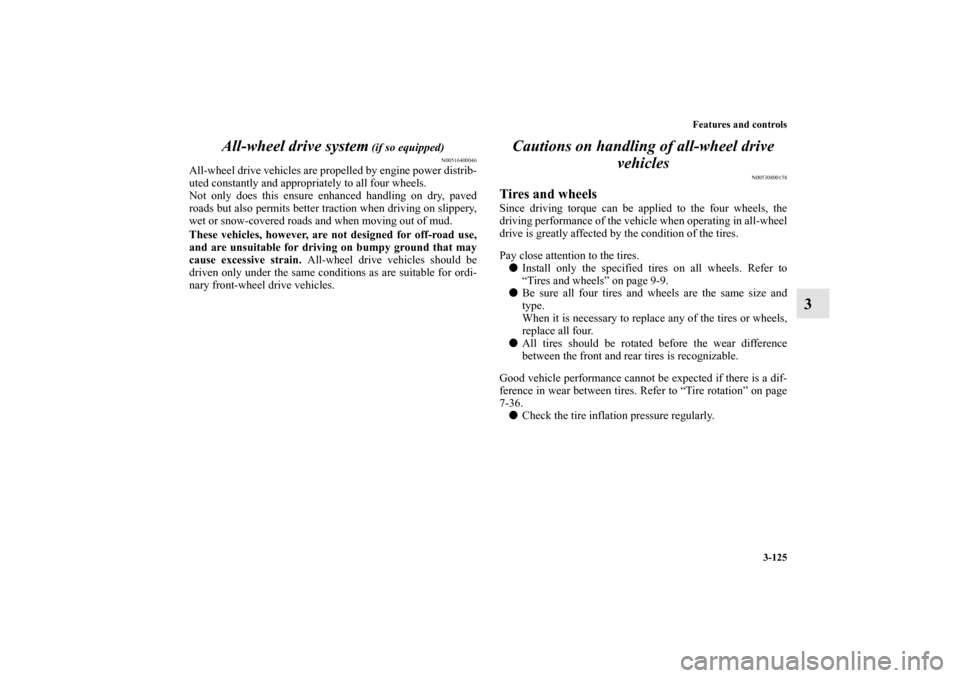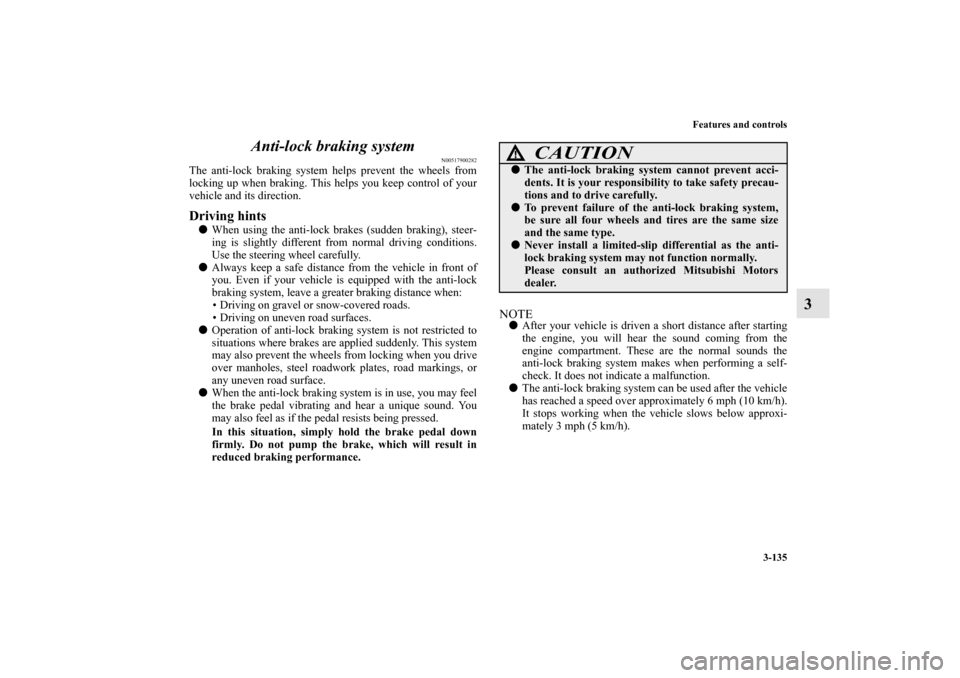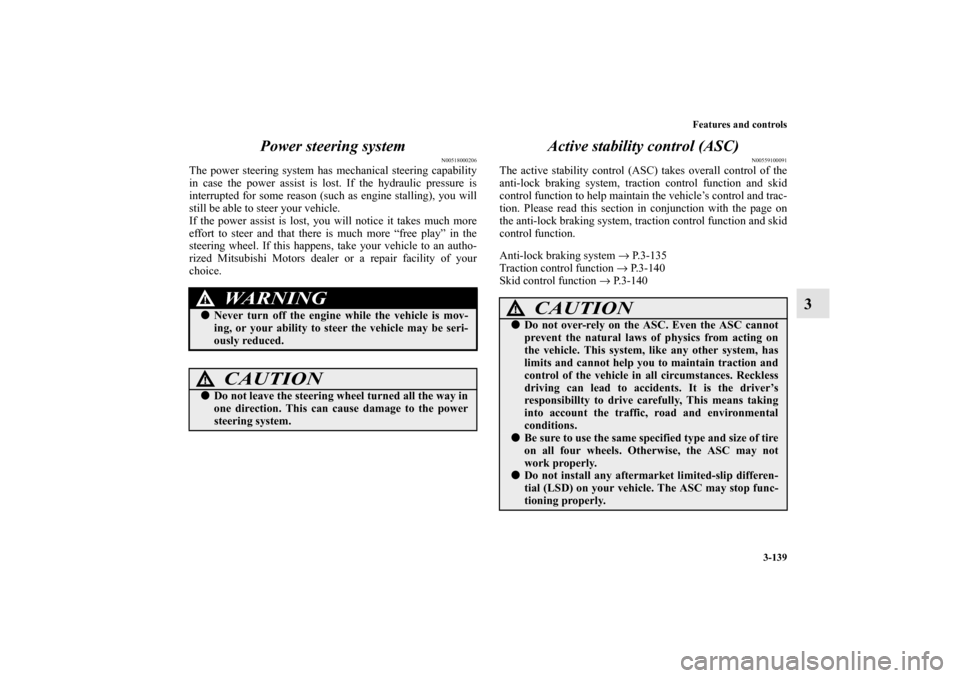Page 220 of 658

Features and controls
3-125
3 All-wheel drive system
(if so equipped)
N00516400046
All-wheel drive vehicles are propelled by engine power distrib-
uted constantly and appropriately to all four wheels.
Not only does this ensure enhanced handling on dry, paved
roads but also permits better traction when driving on slippery,
wet or snow-covered roads and when moving out of mud.
These vehicles, however, are not designed for off-road use,
and are unsuitable for driving on bumpy ground that may
cause excessive strain. All-wheel drive vehicles should be
driven only under the same conditions as are suitable for ordi-
nary front-wheel drive vehicles.
Cautions on handling of all-wheel drive
vehicles
N00530800158
Tires and wheelsSince driving torque can be applied to the four wheels, the
driving performance of the vehicle when operating in all-wheel
drive is greatly affected by the condition of the tires.
Pay close attention to the tires.�
Install only the specified tires on all wheels. Refer to
“Tires and wheels” on page 9-9.
�
Be sure all four tires and wheels are the same size and
type.
When it is necessary to replace any of the tires or wheels,
replace all four.
�
All tires should be rotated before the wear difference
between the front and rear tires is recognizable.
Good vehicle performance cannot be expected if there is a dif-
ference in wear between tires. Refer to “Tire rotation” on page
7-36.
�
Check the tire inflation pressure regularly.
BK0103001US.book 125 ページ 2009年8月20日 木曜日 午前10時45分
Page 222 of 658

Features and controls
3-127
3
Jacking up all-wheel drive vehicles
ACD (Active center differential system)
(if so
equipped)N00538500047
The ACD is a system that improves acceleration performance
and straight-ahead stability by regulating the differential limit-
ing action and power drive distribution of the center differen-
tial.NOTE�
If the parking brake lever is pulled up while the vehicle is
moving, the center differential is designed to switch to a
free state condition which will allow the rear wheel to
lock easier.
WA R N I N G
!�
Do not start or run the engine while the vehicle is on
the jack. The jack could slip out of position and
result in an accident.
CAUTION
!�
Do not over-rely on the ACD. Even the ACD cannot
prevent the natural laws of physics from acting on
the vehicle. This system, like any other system, has
limits and cannot help you to maintain traction and
control of the vehicle in all circumstances. Reckless
driving can lead to accidents. It is the driver’s
responsibility to drive carefully. This means taking
into account the traffic, road and environmental
conditions.
�
Be sure to use tires that are the same specified size,
type, and brand, and have no difference in the
amount of wear for all four wheels. Otherwise, the
ACD may not work properly.
BK0103001US.book 127 ページ 2009年8月20日 木曜日 午前10時45分
Page 230 of 658

Features and controls
3-135
3 Anti-lock braking system
N00517900282
The anti-lock braking system helps prevent the wheels from
locking up when braking. This helps you keep control of your
vehicle and its direction. Driving hints �
When using the anti-lock brakes (sudden braking), steer-
ing is slightly different from normal driving conditions.
Use the steering wheel carefully.
�
Always keep a safe distance from the vehicle in front of
you. Even if your vehicle is equipped with the anti-lock
braking system, leave a greater braking distance when:
Driving on gravel or snow-covered roads.
Driving on uneven road surfaces.
�
Operation of anti-lock braking system is not restricted to
situations where brakes are applied suddenly. This system
may also prevent the wheels from locking when you drive
over manholes, steel roadwork plates, road markings, or
any uneven road surface.
�
When the anti-lock braking system is in use, you may feel
the brake pedal vibrating and hear a unique sound. You
may also feel as if the pedal resists being pressed.
In this situation, simply hold the brake pedal down
firmly. Do not pump the brake, which will result in
reduced braking performance.
NOTE�
After your vehicle is driven a short distance after starting
the engine, you will hear the sound coming from the
engine compartment. These are the normal sounds the
anti-lock braking system makes when performing a self-
check. It does not indicate a malfunction.
�
The anti-lock braking system can be used after the vehicle
has reached a speed over approximately 6 mph (10 km/h).
It stops working when the vehicle slows below approxi-
mately 3 mph (5 km/h).
CAUTION
!�
The anti-lock braking system cannot prevent acci-
dents. It is your responsibility to take safety precau-
tions and to drive carefully.
�
To prevent failure of the anti-lock braking system,
be sure all four wheels and tires are the same size
and the same type.
�
Never install a limited-slip differential as the anti-
lock braking system may not function normally.
Please consult an authorized Mitsubishi Motors
dealer.
BK0103001US.book 135 ページ 2009年8月20日 木曜日 午前10時45分
Page 234 of 658

Features and controls
3-139
3 Power steering system
N00518000206
The power steering system has mechanical steering capability
in case the power assist is lost. If the hydraulic pressure is
interrupted for some reason (such as engine stalling), you will
still be able to steer your vehicle.
If the power assist is lost, you will notice it takes much more
effort to steer and that there is much more “free play” in the
steering wheel. If this happens, take your vehicle to an autho-
rized Mitsubishi Motors dealer or a repair facility of your
choice.
Active stability control (ASC)
N00559100091
The active stability control (ASC) takes overall control of the
anti-lock braking system, traction control function and skid
control function to help maintain the vehicle’s control and trac-
tion. Please read this section in conjunction with the page on
the anti-lock braking system, traction control function and skid
control function.
Anti-lock braking system → P. 3 - 1 3 5
Traction control function → P. 3 - 1 4 0
Skid control function → P. 3 - 1 4 0
WA R N I N G
!�
Never turn off the engine while the vehicle is mov-
ing, or your ability to steer the vehicle may be seri-
ously reduced.CAUTION
!�
Do not leave the steering wheel turned all the way in
one direction. This can cause damage to the power
steering system.
CAUTION
!�
Do not over-rely on the ASC. Even the ASC cannot
prevent the natural laws of physics from acting on
the vehicle. This system, like any other system, has
limits and cannot help you to maintain traction and
control of the vehicle in all circumstances. Reckless
driving can lead to accidents. It is the driver’s
responsibillty to drive carefully, This means taking
into account the traffic, road and environmental
conditions.
�
Be sure to use the same specified type and size of tire
on all four wheels. Otherwise, the ASC may not
work properly.
�
Do not install any aftermarket limited-slip differen-
tial (LSD) on your vehicle. The ASC may stop func-
tioning properly.
BK0103001US.book 139 ページ 2009年8月20日 木曜日 午前10時45分